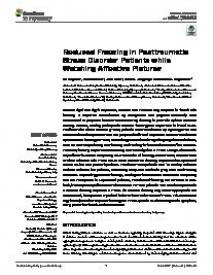Reduced Freezing in Posttraumatic Stress Disorder Patients while Watching Affective Pictures
Besides fight and flight responses, animals and humans may respond to threat with freezing, a response characterized by bradycardia and physical immobility. Risk assessment is proposed to be enhanced during freezing to promote optimal decision making. Indeed, healthy participants showed freezing-like responses to threat cues. Posttraumatic stress disorder (PTSD) patients are characterized by hypervigilance and increased threat responsiveness. We propose that threat responses will be characterized by decreased freezing in PTSD, eliminating possibilities for rejecting cognitive distortions, such as harm expectancy, and thereby contributing to the maintenance of the disorder. However, freezing responses have hardly been investigated in PTSD. Using a stabilometric platform to assess body sway as an indicator of freezing-like behavior, we examined whether veterans with PTSD would show diminished freezing responses to unpleasant versus neutral and pleasant pictures. Fourteen PTSD patients and 14 healthy matched controls watched the pictures, while body sway and heart rate (HR) were continuously assessed. Replicating previous findings, healthy controls showed decreased body sway and HR in response to unpleasant pictures, indicative of freezing-like behavior. In contrast, this response pattern was not observed in PTSD patients. The results may indicate a reduced freezing response in PTSD. As reduced freezing may hinder appropriate risk assessment, it may be an important factor in the maintenance of PTSD. Future research might clarify whether impaired freezing is a PTSD-specific or a transdiagnostic symptom, being present in threat-related disorders.
In: Frontiers in Psychiatry, ISSN 1664-0640 | 8 | March | 39
https://doi.org/10.3389/fpsyt.2017.00039


